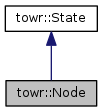|
| | Node (int dim=0) |
| | Constructs a dim - dimensional node (default zero-dimensional). More...
|
| |
| virtual | ~Node ()=default |
| |
| const VectorXd | a () const |
| | read access to the second-derivative of the state, e.g. acceleration. More...
|
| |
| const VectorXd | at (Dx deriv) const |
| | Read the state value or it's derivatives by index. More...
|
| |
| VectorXd & | at (Dx deriv) |
| | Read or write a specific state derivative by index. More...
|
| |
| const VectorXd | p () const |
| | read access to the zero-derivative of the state, e.g. position. More...
|
| |
| | State (int dim, int n_derivatives) |
| | Constructs a state object. More...
|
| |
| const VectorXd | v () const |
| | read access to the first-derivative of the state, e.g. velocity. More...
|
| |
| virtual | ~State ()=default |
| |
A node represents the state of a trajectory at a specific time.
Given a set of nodes, cubic polynomials can be used to smoothly interpolate between them. Therefore, if optimal node values have been found, the continuous trajectory for that spline can be reconstructed.
In this framework a node only has position and velocity values, no acceleration.
Definition at line 107 of file state.h.

 Public Member Functions inherited from towr::State
Public Member Functions inherited from towr::State Public Types inherited from towr::State
Public Types inherited from towr::State